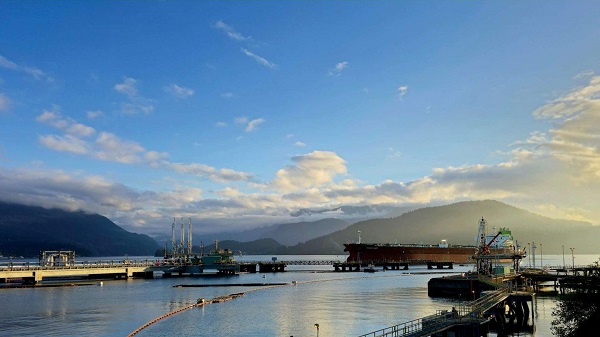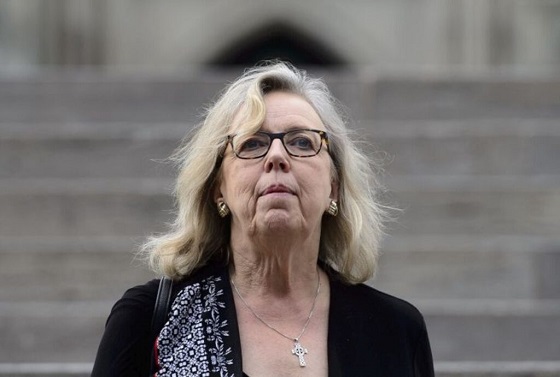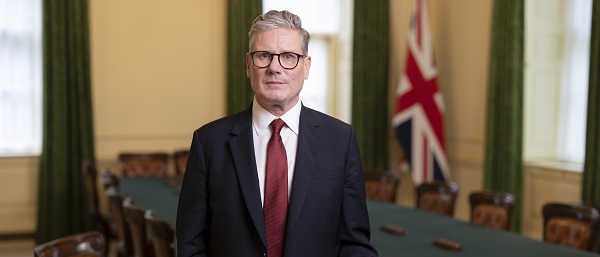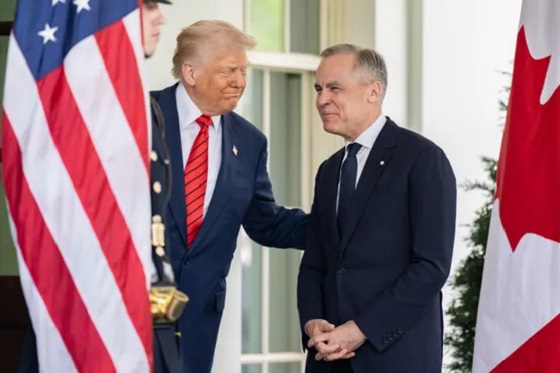Business
Bank of Canada Study Confirms Collapse in Consumer Confidence Amid Trade War Fallout

They chased applause at climate conferences while dismantling the industries that built this country. They ignored working Canadians, sabotaged our energy sector, and hollowed out our economic defenses in the name of “progress.”
A new Bank of Canada report, yes, that Bank of Canada, just confirmed what millions of working Canadians already feel in their bones: the economy is unraveling. Consumer sentiment, the baseline mood of the average Canadian family, has collapsed. And what triggered this historic plunge? Not inflation. Not interest rates. Not even Pierre Poilievre. No—it was Donald Trump.
According to the report, which was quietly released this month, it all started on February 1, 2025. That’s when former President Trump signed an executive order slapping massive tariffs on Canadian exports, steel, aluminum, energy, potash, lumber. You name it. Up to 35% tariffs. And then, because he’s Trump, he doubled down, casually suggesting in speeches that Canada should just become the 51st state. That’s not a joke. That’s annexation rhetoric.
And here’s the kicker, the numbers don’t lie. The Bank of Canada developed a new tool, the so-called CSCE Indicator, to measure consumer expectations. It tracked 2,000 households in real time, right as the trade war ignited. And what did they find? A total wipeout of all economic optimism from 2024. Jobs? Vanishing. Spending intentions? Cratering. Financial outlook? Bleak.
So here’s what we now know, and it’s not a guess. According to their latest report, Canadian consumer sentiment has collapsed. Not dipped. Not softened. Collapsed. Across the board.
They tracked three critical things: how people feel about their financial health, their job security, and whether they’re planning to spend money. Every single one fell off a cliff. The number of Canadians who believe they’ll be worse off financially next year? Surging. The odds that someone thinks they’ll lose their job? Skyrocketing—especially in regions that actually produce things, places that export goods, like steel, aluminum, and lumber. And major purchases? Cars, homes, furniture? Forget it. People aren’t buying. They’re holding their breath.
And here’s where it gets truly damning. This decline—this emotional and economic freefall—can’t even be explained by the usual suspects. Not inflation. Not unemployment. The Bank of Canada ran the numbers, built a full regression model, and what they found was a massive unexplained drop—a “residual” in economist speak. Translation: this isn’t about what’s happening right now. It’s about what people believe is coming next.
And what’s driving that fear? The answer is plain. A trade war launched by a former U.S. president, and public threats—threats—to annex Canada.
A very large portion of this crisis is the fault of the Liberal Party of Canada. That’s not a talking point—it’s a fact. It’s a fact backed by years of missed opportunities, ideological sabotage, and deliberate inaction by two successive Liberal regimes. And now the consequences have arrived, right on schedule.
Let’s be clear. This didn’t start with Trump’s tariffs. This started long before, when Justin Trudeau, and now his heir Mark Carney, decided that building energy infrastructure was just too messy, too politically inconvenient. For nearly a decade, the Liberals rejected every opportunity to make Canada energy independent. Northern Gateway? Cancelled. Energy East? Killed off. Teck Frontier? Abandoned after the government strangled it in red tape. Trans Mountain? Purchased with your tax dollars, then stalled into irrelevance. Every time a project came forward that could have helped this country get oil and gas to global markets, the Liberals caved to foreign-funded environmental groups and elite climate activists with Ivy League degrees and no skin in the game.
They had no vision—none—for a national energy corridor. They didn’t want one. A pipeline that could move Alberta crude to tidewater, or LNG from B.C. to the Atlantic, was dismissed as a relic of a bygone era. It wasn’t woke enough. Instead, they chose Paris climate targets, photo-ops with Greta Thunberg, and empty moral lectures at Davos. The result? When America decided to weaponize energy policy and slap tariffs on Canadian oil and gas, we had no fallback. No leverage. No global customers. Just bottlenecks and apologies.
And then there’s the LNG disaster. Remember when Deputy Prime Minister Chrystia Freeland said there was “no business case” for LNG on the East Coast? She wasn’t alone. Her former Natural Resources Minister, Jonathan Wilkinson, said the same thing. No business case. This, as Qatar signed over $60 billion in LNG deals with Europe. As the United States became the largest LNG exporter on Earth. As Germany, desperate for alternatives to Russian gas, pleaded with Canada to send help. We said no. Not because we couldn’t do it. But because the Liberals didn’t want to. It wasn’t aligned with their green ideology. It would offend the climate lobby. And so they let the opportunity pass.
And this—this is exactly what happens when you let a part-time drama teacher run a G7 country like it’s a college theater troupe. This is what Liberal governance looks like in practice: performative, reckless, and utterly disconnected from the real world. They chased applause at climate conferences while dismantling the industries that built this country. They ignored working Canadians, sabotaged our energy sector, and hollowed out our economic defenses in the name of “progress.”
And now? Now we’re supposed to hand the firehose to the very people who started the fire. The same elites who told us there was “no business case” for LNG. The same crowd who canceled pipelines, ignored warnings, and left us totally exposed to a geopolitical and economic assault.
It’s 2025. The country is staggering. And the architects of this collapse—the Trudeau-Carney Liberals—have the audacity to ask for our trust again. They want more time. More power. More control.
No. They’ve had a decade. They lit the match, doused the economy in kerosene, and now they’re pretending they smell smoke for the first time.
Canadians shouldn’t fall for it. We don’t need more empty virtue signaling. We need competence. Backbone. And leadership grounded in reality—not staged in front of a mirror.
Subscribe to The Opposition with Dan Knight .
For the full experience, upgrade your subscription.
Business
US Energy Secretary says price of energy determined by politicians and policies


From the Daily Caller News Foundation
During the latest marathon cabinet meeting on Dec. 2, Energy Secretary Chris Wright made news when he told President Donald Trump that “The biggest determinant of the price of energy is politicians, political leaders, and polices — that’s what drives energy prices.”
He’s right about that, and it is why the back-and-forth struggle over federal energy and climate policy plays such a key role in America’s economy and society. Just 10 months into this second Trump presidency, the administration’s policies are already having a profound impact, both at home and abroad.
While the rapid expansion of AI datacenters over the past year is currently being blamed by many for driving up electric costs, power bills were skyrocketing long before that big tech boom began, driven in large part by the policies of the Obama and Biden administration designed to regulate and subsidize an energy transition into reality. As I’ve pointed out here in the past, driving up the costs of all forms of energy to encourage conservation is a central objective of the climate alarm-driven transition, and that part of the green agenda has been highly effective.
Dear Readers:
As a nonprofit, we are dependent on the generosity of our readers.
Please consider making a small donation of any amount here.
Thank you!
President Trump, Wright, and other key appointees like Interior Secretary Doug Burgum and EPA Administrator Lee Zeldin have moved aggressively throughout 2025 to repeal much of that onerous regulatory agenda. The GOP congressional majorities succeeded in phasing out Biden’s costly green energy subsidies as part of the One Big Beautiful Bill Act, which Trump signed into law on July 4. As the federal regulatory structure eases and subsidy costs diminish, it is reasonable to expect a gradual easing of electricity and other energy prices.
This year’s fading out of public fear over climate change and its attendant fright narrative spells bad news for the climate alarm movement. The resulting cracks in the green facade have manifested rapidly in recent weeks.
Climate-focused conflict groups that rely on public fears to drive donations have fallen on hard times. According to a report in the New York Times, the Sierra Club has lost 60 percent of the membership it reported in 2019 and the group’s management team has fallen into infighting over elements of the group’s agenda. Greenpeace is struggling just to stay afloat after losing a huge court judgment for defaming pipeline company Energy Transfer during its efforts to stop the building of the Dakota Access Pipeline.
350.org, an advocacy group founded by Bill McKibben, shut down its U.S. operations in November amid funding woes that had forced planned 25 percent budget cuts for 2025 and 2026. Employees at EDF voted to form their own union after the group went through several rounds of budget cuts and layoffs in recent months.
The fading of climate fears in turn caused the ESG management and investing fad to also fall out of favor, leading to a flood of companies backtracking on green investments and climate commitments. The Net Zero Banking Alliance disbanded after most of America’s big banks – Goldman Sachs, J.P. Morgan Chase, Citigroup, Wells Fargo and others – chose to drop out of its membership.
The EV industry is also struggling. As the Trump White House moves to repeal Biden-era auto mileage requirements, Ford Motor Company is preparing to shut down production of its vaunted F-150 Lightning electric pickup, and Stellantis cancelled plans to roll out a full-size EV truck of its own. Overall EV sales in the U.S. collapsed in October and November following the repeal of the $7,500 per car IRA subsidy effective Sept 30.
The administration’s policy actions have already ended any new leasing for costly and unneeded offshore wind projects in federal waters and have forced the suspension or abandonment of several projects that were already moving ahead. Capital has continued to flow into the solar industry, but even that industry’s ability to expand seems likely to fade once the federal subsidies are fully repealed at the end of 2027.
Truly, public policy matters where energy is concerned. It drives corporate strategies, capital investments, resource development and movement, and ultimately influences the cost of energy in all its forms and products. The speed at which Trump and his key appointees have driven this principle home since Jan. 20 has been truly stunning.
David Blackmon is an energy writer and consultant based in Texas. He spent 40 years in the oil and gas business, where he specialized in public policy and communications.
Business
Oil tanker traffic surges but spills stay at zero after Trans Mountain Expansion

From the Canadian Energy Centre
Bigger project maintains decades-long marine safety record
The Trans Mountain system continues its decades-long record of zero marine spills, even as oil tanker traffic has surged more than 800 per cent since the pipeline’s expansion in May 2024.
The number of tankers calling at Trans Mountain’s Westridge Marine Terminal in the Port of Vancouver in one month now rivals the number that used to go through in one year.
A global trend toward safer tanker operations
Trans Mountain’s safe operations are part of a worldwide trend. Global oil tanker traffic is up, yet spills are down, according to the International Tanker Owners Pollution Federation, a London, UK-based nonprofit that provides data and response support.
Transport Canada reports a 95 per cent drop in ship-source oil spills and spill volumes since the 1970s, driven by stronger ship design, improved response and better regulations.
“Tankers are now designed much more safely. They are double-hulled and compartmentalized to mitigate spills,” said Mike Lowry, spokesperson for the Western Canada Marine Response Corporation (WCMRC).
WCMRC: Ready to protect the West Coast

One of WCMRC’s new response vessels arrives in Barkley Sound. Photo courtesy Western Canada Marine Response Corporation
From eight marine bases including Vancouver and Prince Rupert, WCMRC stands at the ready to protect all 27,000 kilometres of Canada’s western coastline.
Lowry sees the corporation as similar to firefighters — training to respond to an event they hope they never have to see.
In September, it conducted a large-scale training exercise for a worst-case spill scenario. This included the KJ Gardner — Canada’s largest spill response vessel and a part of WCMRC’s fleet since 2024.
“It’s part of the work we do to make sure everybody is trained and prepared to use our assets just in case,” Lowry said.
Expanding capacity for Trans Mountain

The K.J. Gardner is the largest-ever spill response vessel in Canada. Photo courtesy Western Canada Marine Response Corporation
WCMRC’s fleet and capabilities were doubled with a $170-million expansion to support the Trans Mountain project.
Between 2012 and 2024, the company grew from 13 people and $12 million in assets to more than 200 people and $213 million in assets.
“About 80 per cent of our employees are mariners who work as deckhands, captains and marine engineers on our vessels,” Lowry said.
“Most of the incidents we respond to are small marine diesel spills — the last one was a fuel leak from a forest logging vessel near Nanaimo — so we have deployed our fleet in other ways.”
Tanker safety starts with strong rules and local expertise

Tanker loading at the Westridge Marine Terminal in the Port of Vancouver. Photo courtesy Trans Mountain Corporation
Speaking on the ARC Energy Ideas podcast, Trans Mountain CEO Mark Maki said tanker safety starts with strong regulations, including the use of local pilots to guide vessels into the harbour.
“On the Mississippi River, you have Mississippi River pilots because they know how the river behaves. Same thing would apply here in Vancouver Harbour. Tides are strong, so people who are familiar with the harbor and have years and decades of experience are making sure the ships go in and out safely,” Maki said.
“A high standard is applied to any ship that calls, and our facility has to meet very strict requirements. And we have rejected ships, just said, ‘Nope, that one doesn’t fit the bill.’ A ship calling on our facilities is very, very carefully looked at.”
Working with communities to protect sensitive areas
Beyond escorting ships and preparing for spills, WCMRC partners with coastal communities to map sensitive areas that need rapid protection including salmon streams, clam beds and culturally important sites like burial grounds.
“We want to empower communities and nations to be more prepared and involved,” Lowry said.
“They can help us identify and protect the areas that they value or view as sensitive by working with our mapping people to identify those areas in advance. If we know where those are ahead of time, we can develop a protection strategy for them.”
-

 Energy2 days ago
Energy2 days agoA look inside the ‘floatel’ housing B.C.’s LNG workforce
-

 National2 days ago
National2 days agoAlberta will use provincial laws to stop Canadian gov’t from trying to confiscate legal firearms
-

 Energy2 days ago
Energy2 days agoELZABETH MAY HAS IT WRONG: An Alberta to Prince Rupert Oil Pipeline Will Contribute to Greater Global Oil Tanker Safety
-

 illegal immigration1 day ago
illegal immigration1 day agoWhile Trump has southern border secure, hundreds of thousands of illegal immigrants still flooding in from Canada
-

 Censorship Industrial Complex1 day ago
Censorship Industrial Complex1 day agoCanadian bishops condemn Liberal ‘hate speech’ proposal that could criminalize quoting Scripture
-

 COVID-192 days ago
COVID-192 days agoCanadian legislator introduces bill to establish ‘Freedom Convoy Recognition Day’ as a holiday
-

 Censorship Industrial Complex1 day ago
Censorship Industrial Complex1 day agoForeign Leaders Caught Orchestrating Campaign To Censor American Right-Wing Media Companies
-

 Business2 days ago
Business2 days agoUS Energy Secretary says price of energy determined by politicians and policies







